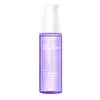What's inside
What's inside
 Key Ingredients
Key Ingredients

 Benefits
Benefits

 Concerns
Concerns

 Ingredients Side-by-side
Ingredients Side-by-side

Paraffinum Liquidum
EmollientEthylhexyl Palmitate
EmollientVitis Vinifera Seed Oil
EmollientCanola Oil
EmollientSorbeth-30 Tetraoleate
EmulsifyingOlea Europaea Fruit Oil
MaskingPEG-20 Glyceryl Triisostearate
EmollientPhenoxyethanol
PreservativeRosmarinus Officinalis Leaf Oil
MaskingTocopherol
AntioxidantLimnanthes Alba Seed Oil
Skin ConditioningSqualane
EmollientCaprylic/Capric Triglyceride
MaskingWater
Skin ConditioningGlycyrrhiza Uralensis Root Extract
Skin ConditioningGlycerin
HumectantCamellia Sinensis Extract
AntioxidantParaffinum Liquidum, Ethylhexyl Palmitate, Vitis Vinifera Seed Oil, Canola Oil, Sorbeth-30 Tetraoleate, Olea Europaea Fruit Oil, PEG-20 Glyceryl Triisostearate, Phenoxyethanol, Rosmarinus Officinalis Leaf Oil, Tocopherol, Limnanthes Alba Seed Oil, Squalane, Caprylic/Capric Triglyceride, Water, Glycyrrhiza Uralensis Root Extract, Glycerin, Camellia Sinensis Extract
Ingredients Explained
These ingredients are found in both products.
Ingredients higher up in an ingredient list are typically present in a larger amount.
Ethylhexyl Palmitate, also known as octyl palmitate, is created from 2-ethylhexyl alcohol and palmitic acid. It is a fatty acid ester.
The fatty acid content of Ethylhexyl Palmitate makes it an emollient. Emollients help soften and hydrate your skin by trapping moisture within.
Ethylhexyl Palmitate is also used to help improve the texture of cosmetics. It helps other ingredient dissolve in products and help disperse ingredients more evenly.
You'll likely find this ingredient in sunscreen, as it is often used to mix UV-blocking ingredients such as avobenzone and ethylhexyl triazone.
It can also help stabilize the fragrances in a product as a fragrance fixative.
Ethylhexyl Palmitate can be used to substitute mineral oil.
Due to its high fatty acid content, it may not be fungal-acne safe.
Learn more about Ethylhexyl PalmitatePeg-20 Glyceryl Triisostearate comes from Isostearic Acid and glycerin.
It is an emollient, emulsifier, and gentle cleanser. As an emollient, it helps trap moisture to keep skin soft and hydrated. Emulsifiers help prevent ingredients from separating.
This ingredient is common in oil-based products. This is because it helps oil-ingredients be easily washed away without leaving a residue.
Peg-20 Glyceryl Triisostearate may not be fungal-acne safe.
Learn more about PEG-20 Glyceryl TriisostearateTocopherol (also known as Vitamin E) is a common antioxidant used to help protect the skin from free-radicals and strengthen the skin barrier. It's also fat soluble - this means our skin is great at absorbing it.
Vitamin E also helps keep your natural skin lipids healthy. Your lipid skin barrier naturally consists of lipids, ceramides, and fatty acids. Vitamin E offers extra protection for your skin’s lipid barrier, keeping your skin healthy and nourished.
Another benefit is a bit of UV protection. Vitamin E helps reduce the damage caused by UVB rays. (It should not replace your sunscreen). Combining it with Vitamin C can decrease sunburned cells and hyperpigmentation after UV exposure.
You might have noticed Vitamin E + C often paired together. This is because it is great at stabilizing Vitamin C. Using the two together helps increase the effectiveness of both ingredients.
There are often claims that Vitamin E can reduce/prevent scarring, but these claims haven't been confirmed by scientific research.
Learn more about TocopherolWater. It's the most common cosmetic ingredient of all. You'll usually see it at the top of ingredient lists, meaning that it makes up the largest part of the product.
So why is it so popular? Water most often acts as a solvent - this means that it helps dissolve other ingredients into the formulation.
You'll also recognize water as that liquid we all need to stay alive. If you see this, drink a glass of water. Stay hydrated!
Learn more about Water